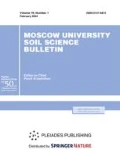Abstract
Roadside soils along Leningradskoe Highway are ecotoxicologically assessed by the laboratory phytotest method based on two test cultures. The research was carried out along a 300-m-long transect established perpendicular to the highway. The toxicity of soils, determined according to inhibition of the growth parameters of Lepidium sativum L. (cress) and Hordeum vulgare L. (rye), has been revealed in the majority of the studied area and is characterized by a bimodal distribution: it is maximum at a distance of several meters from the highway (dangerously and moderately toxic soils), sharply decreases at a distance of 7 m from it, and gradually increases again towards the end of the studied zone (moderately toxic soils). The degree of phytotoxicity is differentiated depending on the test culture variant: H. vulgare was characterized by a lower sensitivity to pollutants and did not reveal toxicity in the 7–25 m zone from Leningradskoe Highway, while L. sativum revealed toxicity of soils throughout the investigated area. Among the analyzed test parameters, root and seedling length were the most sensitive to pollutants, while seed germination was uninformative.
Similar content being viewed by others
References
Bardina, T.V., Chugunova, M.V., and Bardina, V.I., The way to research ecotoxicity by means of biotests, Zhivye Biokosn. Sist., 2013, no. 5.
Vadyunina, A.F. and Korchagina, Z.A., Metody issledovaniya fizicheskikh svoistv pochv (Methods for Researching Soils Physical Properties), Moscow, 1986.
Vorob’eva, L.A., Glebova, G.I., Gorshkova, E.I., et al., Fiziko-khimicheskie metody issledovaniya pochv (Physical and Chemical Methods for Soils Research), Zyrin, N.G. and Orlov, D.S., Eds., Moscow, 1980.
Kapel’kina, L.P., Bardina, T.V., Bakina, L.G., et al., M-P-2006 FR.1.39.2006.02264. Metodika vypolneniya izmerenii vskhozhesti semyam i dliny kornei prorostkov vysshikh rastenii dlya opredeleniya toksichnosti tekhnogennozagryaznennykh pochv (M-P-2006 FR.1.39.2006.02264: Method of Measurement of Seed Germination Ability and Length of the Roots of Seedlings of Higher Plants to Determine the Toxicity of Anthropogenically Polluted Soils), St. Petersburg, 2009.
Lisovitskaya, O.V. and Terekhova, V.A., Phytotesting: the main approaches, problems of laboratory method and modern solutions, Dokl. Ekol. Pochvoved., 2010, no. 1, issue 13.
Makarov, O.A., Kareva, O.V., Chistova, O.A., et al., The way to measure near road soils pollution by heavy metals (by the example of Educational-Experimental Soil-Ecological Center of Moscow State University “Chashnikovo”), Ekol. Urban. Territ., 2017, no. 1.
PND F 16.1:2.2.22-98. Metodika vypolneniya izmerenii massovoi doli nefteproduktov v mineral’nykh, organogennykh, organo-mineral’nykh pochvakh i donnykh otlozheniyakh metodom IK-spektrometrii (PND F 16.1:2.2.22-98: Method of Measurement of Mass Fraction of Petroleum Products in Mineral, Orgenogenic, Organic-Mineral Soils and Bottom Sediments by IR Spectrometry), Moscow, 2005.
Nikolaeva, O.V. and Terekhova, V.A., Improvement of laboratory phytotest for the ecological evaluation of soils, Eurasian Soil Sci., 2017, vol. 50, no. 9, p. 1105.
Orlov, D.S. and Grishina, L.A., Praktikum po khimii gumusa (Practical Works on Humus Chemistry), Moscow, 1981.
Teoriya i praktika khimicheskogo analiza pochv (Soils Chemical Analysis: Theory and Practice), Vorob’eva, L.A., Ed., Moscow, 2006.
Terekhova, V.A., Voronina, L.P., Nikolaeva, O.V., et al., The way to apply phytotesting for solving problems of ecological soil science, Ispol’z. Okhrana Prirod. Resur. Ross., 2016, no. 3.
Terekhova, V.A., Gershkovich, D.M., Gladkova, M.M., et al., Biotestirovanie v ekologicheskom kontrole (Biotests in Ecological Monitoring), Terekhova, V.A., Ed., Moscow, 2017.
van Bohemen, H.D. and van De Laak, W.H.J., The influence of road infrastructure and traffic on soil, water, and air quality, Environ. Manage., 2003, vol. 31, no. 1, pp. 50–68.
Dierkes, C. and Geiger, W., Pollution retention capabilities of roadside soils, Water Sci. Technol., 1999, vol. 39, no. 2, pp. 201–208.
Galuszka, A., Migaszewski, Z., Podlaski, R., et al., The influence of chloride deicers on mineral nutrition and the health status of roadside trees in the city of Kielce, Poland, Environ. Monit. Assess, 2011, vol. 176, nos. 1–4, pp. 451–464.
ISO 11269-2:2012: Soil Quality-Determination of the Effects of Pollutants on Soil Flora, Part 2: Effects of Contaminated Soil on the Emergence and Early Growth of Higher Plants, Geneva: Int. Stand. Org., 2012.
Nikolaeva, O.V., Karpukhin, M.M., and Rozanova, M.S., Distribution of traffic-related contaminants in urban topsoils across a highway in Moscow, J. Soils Sedim., 2017, vol. 17, no. 4, pp.1045–1053.
OCSPP 850.4230: Early Seedling Growth Toxicity Test [EPA 712-C-010], Washington, DC: United States Environ. Prot. Agency, 2012.
OECD Guidelines for the Testing of Chemicals, Section 2, Test no. 208: Terrestrial Plant Test: Seedling Emergence and Seedling Growth Test, Paris: Org. Econ. Co-operation Dev., 2006.
Trofimov, S.Y. and Rozanova, M.S., Transformation of soil properties under the impact of oil pollution, Eurasian Soil Sci., 2003, vol. 36, pp. S82–S87.
Werkenthin, M., Kluge, B., and Wessolek, G., Metals in European roadside soils and soil solution?a review, Environ. Pollut., 2014, vol. 189, pp. 98–110.
Zechmeister, H., Hohenwallner, D., Riss, A., and Hanus-Illnar, A., Estimation of element deposition derived from road traffic sources by using mosses, Environ. Pollut., 2005, vol. 138, no. 2, pp. 238–249.
Zehetner, F., Rosenfellner, U., Mentler, A., and Gerzabek, M., Distribution of road salt residues, heavy metals and polycyclic aromatic hydrocarbons across a highway-forest interface, Water, Air, Soil Pollut., 2009, vol. 198, nos. 1–4, pp. 125–132.
Author information
Authors and Affiliations
Corresponding authors
Additional information
Russian Text © O.V. Nikolaeva, O.A. Chistova, N.N. Panina, M.S. Rozanova, 2019, published in Vestnik Moskovskogo Universiteta, Seriya 17: Pochvovedenie, 2019, No. 1, pp. 28–34.
About this article
Cite this article
Nikolaeva, O.V., Chistova, O.A., Panina, N.N. et al. Ecotoxicological Assessment of Roadside Soils in Areas along Leningradskoe Highway Using Laboratory Phytotesting. Moscow Univ. Soil Sci. Bull. 74, 26–32 (2019). https://doi.org/10.3103/S0147687419010083
Received:
Published:
Issue Date:
DOI: https://doi.org/10.3103/S0147687419010083




